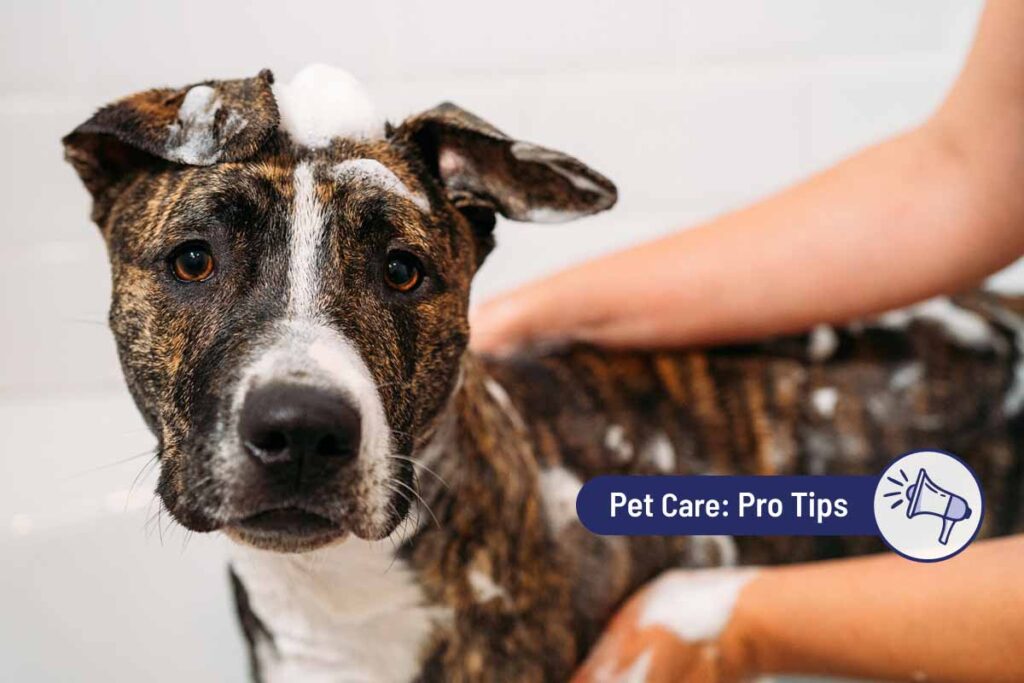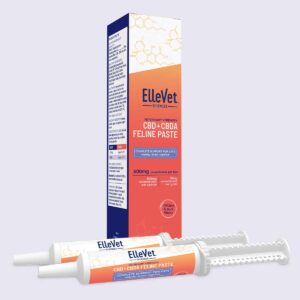Reviewed by: Dr. Robert Menardi, DVM
Mange in dogs is a skin condition caused by parasitic mites that live on or under the dog’s skin. While mange is a treatable condition, it can be uncomfortable for affected dogs, often leading to hair loss and intense itching while jeopardizing your dog’s health.
It’s important for dog parents to understand the different types of mange, the causes, symptoms, and treatment options to help better care for their dog.
What Is Mange?
Mange is a skin disease caused by an infestation of parasitic mites. These mites burrow into or live on the surface of the dog’s skin, causing intense irritation. Mange can cause a variety of symptoms, including hair loss, redness, crusty skin, and severe itchiness.
Types of Mange
There are two main types of mange in dogs: sarcoptic mange and demodectic mange. They may present similarly, but they’re completely different conditions that require different courses of treatment.
Sarcoptic mange
Sarcoptic mange, also known as canine scabies, is caused by the Sarcoptes scabiei mite. This type of mange is highly contagious and can be transmitted through direct contact with an infected dog or contaminated objects, such as bedding, grooming tools, or kennel surfaces. Sarcoptic mites burrow into the skin, causing itching and irritation.
Symptoms of Sarcoptic Mange
- Intense itching (pruritus), often leading to excessive scratching
- Hair loss (especially around the ears, face, and abdomen)
- Red, inflamed skin
- Crusty scabs or skin lesions
- Thickened, darkened skin
- Secondary bacterial skin infections
Sarcoptic mange is often difficult to diagnose because the mites are hard to find on skin scrapings. The symptoms and the pattern of itching can strongly indicate this type of mange, as can the diagnosis of canine scabies in another dog your dog may have come into contact with.
Demodectic Mange (Demodicosis)
Demodectic mange, also known as red mange or demodicosis, is caused by Demodex canis mites. Unlike sarcoptic mange, demodectic mange is not highly contagious, and these mites are a normal part of the dog’s skin.
In healthy dogs, the immune system keeps the Demodex mites under control. However, in puppies, older dogs, or dogs with a weakened immune system, mites can multiply and cause skin problems.
Symptoms of Demodectic Mange
- Hair loss, especially around the eyes, mouth, and paws
- Red, inflamed skin
- Crusty lesions
- Skin infections, including bacterial and yeast infections
- Enlarged lymph nodes in severe cases
Demodectic mange in dogs can present in two forms: localized demodicosis and generalized demodicosis. Localized demodicosis affects only a small area of the dog’s body and often resolves on its own. Generalized demodicosis is more severe and affects large areas of the dog’s skin, often leading to widespread hair loss, scabs, and secondary infections.
The Life Cycle of Mange Mites
Both sarcoptic mites and Demodex mites have a life cycle that directly impacts the way mange will affect your dog and how the condition will respond to treatment.
Sarcoptic Mites
Sarcoptes scabiei mites burrow into the dog’s skin to lay eggs. After hatching, the larvae mature and continue the cycle of burrowing and causing skin irritation. A sarcoptic mite can live about 30 days, laying eggs and leading to more severe symptoms.
Demodex Mites
Demodex canis mites live in the hair follicles of the dog’s skin. They are part of the dog’s natural skin environment but can multiply uncontrollably in dogs with a weakened immune system. The life cycle of Demodex mites is completed entirely on the dog’s body, with the mites feeding on skin cells and oils.
What Causes Mange in Dogs?
The primary cause of mange in dogs is an infestation of mites. However, certain factors can make a dog more prone to developing mange. Dogs with compromised immune systems, such as puppies, elderly dogs, or those with underlying health conditions, are more susceptible to demodectic mange.
Sarcoptic mange mites are often spread through direct contact with infected dogs or contaminated objects. This is particularly common in crowded environments like kennels. Poor living conditions, lack of proper grooming, and stress can increase the risk of mange in dogs.
Diagnosing Mange in Dogs
To diagnose mange, veterinarians typically perform a skin scraping or skin biopsy to identify the type of mites involved. However, diagnosing sarcoptic mange can be challenging because the mites burrow deep into the skin and may not appear in the scraping.
Your veterinarian will assess the dog’s symptoms, especially the pattern of hair loss and itchiness. Blood tests may help evaluate the dog’s overall health and immune function.
In severe or unclear cases, a small piece of skin may be removed and examined under a microscope. A biopsy can provide your veterinarian with invaluable information about the extent of the infection and how to best approach treatment.
Treating Mange in Dogs
The treatment for mange depends on the type and severity of the infestation. In both sarcoptic mange and demodectic mange, early diagnosis and prompt treatment are essential to prevent complications like secondary skin infections.
Topical Medications
Topical treatments are often the first line of defense in treating mange. These treatments can help kill the mites on the dog’s skin and reduce symptoms like itching and inflammation. Common topical treatments include medicated shampoos or creams that target mites.
Oral Medications
In more severe cases of mange, oral medications may be prescribed to help eliminate the mite infestations. These medications may include antiparasitic drugs like ivermectin or milbemycin. Oral medications can be highly effective in reducing the mite population and alleviating symptoms.
Treating Secondary Infections
Infected dogs with secondary bacterial or yeast infections may require additional treatments, such as antibiotics or antifungal medications, to resolve the skin infection and promote healing.
Improving Your Dog’s Immune System
In cases of demodectic mange, strengthening the dog’s immune system is crucial for managing the condition. Ensuring that your dog is on a balanced, nutritious diet and addressing any underlying health conditions can help prevent future outbreaks.
Environmental Control
For sarcoptic mange, it’s essential to clean and disinfect your dog’s environment, including bedding, grooming tools, and any other items that could harbor sarcoptic mites. This helps prevent reinfestation and protects other pets in the household. health. It’s important to consult your veterinarian if you suspect your pet is suffering from mange.
Preventing Mange in Dogs
Preventing mange involves maintaining your dog’s overall health and hygiene. Even excellent pet parents can experience mange in their household, especially due to the irresponsibility of other pet owners. Remain vigilant, groom your dog well, and make holistic choices to support their immune system.
Groom Your Dog Effectively
Brush your dog’s coat regularly to remove dirt, dead skin, and any potential mites. Bathing your dog with a gentle, veterinarian approved shampoo can also help keep their skin healthy.
If you use a professional groomer, be very mindful of the groomer’s facility and reputation. If a dog with sarcoptic mange is groomed in the same facility, it’s possible that mange may spread to other dogs.
Promote a Healthy Immune System
Feed your dog a balanced diet to support their immune system and keep their skin and coat healthy. Low-quality dog food is often insufficient in vitamins and minerals your dog needs for a strong immune system. Make sure your dog is up to date on their vaccines and adequately treat any underlying health conditions.
Manage Your Dog’s Environment
Keep your dog’s living space clean and free from potential mite infestations. This is especially important if your dog spends time in crowded places like kennels. It’s generally safer to have a trusted person dog sit for you if you’ve going to be out of town.
When To See a Veterinarian
If your dog shows any signs of mange, such as hair loss, itching, or skin lesions, it’s important to visit your veterinarian as soon as possible. Severe cases of mange can lead to complications like skin infections, so early intervention is crucial. Sarcoptic mange cannot be treated at home and is highly contagious to other animals. Even if it is not mites, there are other causes of hair loss and itching that your veterinarian can diagnose and treat.
In Conclusion: Mange Requires Intervention
Mange in dogs is a treatable condition, but it can cause discomfort and distress for your pet. Recognizing the symptoms and seeking prompt veterinary care will help your dog recover from mange. The keys to successful treatment are early diagnosis and proper care, use prevention strategies to ensure the health and happiness of your four-legged companion.
Sources:
Treatment of Canine Sarcoptic Mange | Gatorland Animal Services SOPs
Demodicosis: New treatment, common misdiagnosis | PMC
What Is a Biopsy? Purpose & Results | Cleveland Clinic
Fresh vs Raw Dog Food vs Kibble: Which Diet Is Best For Your Dog? | American Kennel Club
Any health or medical information in ElleVet blogs is from a variety of public and reputable sources. This information is intended as an educational resource only and is not a substitute for expert professional care.








